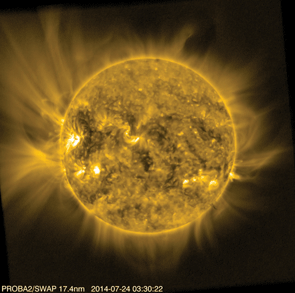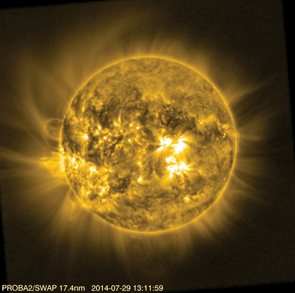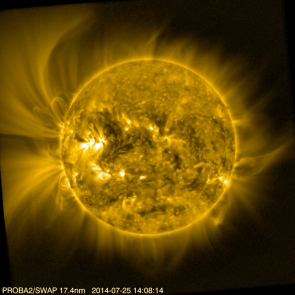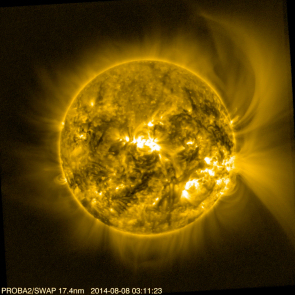SWAP spies acrobatics in Sun's shape-shifting atmosphere
16 March 2015
Our view of the Sun is constantly changing. Looping filaments and energetic flares fly outwards from its turbulent surface, and its face is often marked by inky-black sunspots. The Sun's activity varies over a roughly 11-year cycle and, although its motion may not be that noticeable in the sky, it rotates about once every 27 days. All of this creates an ever-shifting picture of our star.| Time-lapse video of the Sun's shape-shifting atmosphere viewed by PROBA2's SWAP camera. Click here for video details and downloads. Credit: ESA/ROB |
Surrounding the tumultuous solar surface is the chaotic corona, a rarified atmosphere of super-heated plasma that blankets the Sun and extends out into space for millions of kilometres. This plasma reaches temperatures of several million degrees in some regions – significantly hotter than the Sun's surface itself, which reaches comparatively paltry temperatures of around 6000 degrees.
We can view the corona in visible light from Earth during solar eclipses: on these occasions the Moon blocks the Sun's bright disc from view and the corona can be seen shining brightly in the dark sky. However, as eclipses are infrequent and only last for minutes at a time, this method cannot be used to obtain long-term observations of the corona nor to study its dynamic behaviour. For this, we need a sun-gazer like ESA's PROBA2 satellite, which sees the hot plasma of the corona both on and above the solar disc.
This time-lapse video from PROBA2 shows rarely seen features in the Sun's corona. PROBA2's SWAP (Sun Watcher with APS detector and Image Processing) instrument has been monitoring the Sun since February 2010 and, as seen in this sequence from July and August 2014, produces striking views showing the three-dimensional structure of the corona.
SWAP's ability to observe extreme-ultraviolet light – typically emitted by very hot objects – gives a truly unique view, showing how the Sun's corona changes and evolves over time. Due to its large viewing angle, PROBA2 sees a region of the corona not seen by the other solar workhorses, including the ESA/NASA Solar and Heliospheric Observatory (SOHO), and NASA's Solar Dynamics Observatory (SDO).
The coronal plasma glows in ultraviolet and extreme-ultraviolet light due to its extremely high temperature. By picking one particular wavelength – a very narrow band centred at 17.4 nm – SWAP is able to single out structures with temperatures of around one million degrees.
As seen in the video, this hot plasma forms large loops and surprisingly long-lived fan-shaped structures, both of which are kept in check by the Sun's intense magnetic field. While some of these loops stay close to the surface of the Sun, some stretch far out into space, eventually being swept up into the solar wind – an outpouring of energetic particles that constantly streams out into the Solar System and flows past the planets, including Earth.
Even loops that initially appear to be quite docile can become tightly wrapped and tangled over time, storing energy until they eventually snap and throw off intense flares and eruptions known as coronal mass ejections. These eruptions, made up of massive amounts of gas embedded in magnetic field lines, once reaching the neighbourhood of the Earth can be dangerous for space-based satellites, interfere with communication equipment and damage vital infrastructure on Earth.
As clearly shown in the SWAP images and video, the coronal loops are so bright – and therefore hot – that energy must somehow be transported from the Sun's interior to keep them heated. Figuring out how this happens is key to understanding the complex relationship between the corona and the solar wind.
The video shows the surface of our star in great detail; the disc is a rippling mix of bright regions and dark snaking filaments that wrap around the star. These cool filaments appear to be slightly suspended in the Sun's atmosphere, with thin strands keeping them secured to the surface.
The intensely bright regions are known as active areas, regions where the solar magnetic field is incredibly strong, roughly 10 000 times stronger than the Earth's magnetic field, and can reach temperatures upwards of several million degrees. Bright loops and diffuse fans of coronal plasma seem to be associated with these brightly glowing patches, and pop into view at the star's edge as the active regions rotate into and out of view.
Impressive, sweeping fans can be seen in the SWAP video (for example, at 14:08:14 on 25 July and at 03:11:23 on 8 August), pouring out of the sides of the Sun and continuing all the way up to the north pole – these frames may show the same fan as it rotates in and out of view. The fan seen on 8 August goes on to arch round and connect to the Sun at its north pole, a connection that is seen intermittently for a few weeks.
The Sun's magnetic field also gives rise to features known as streamers and pseudostreamers – elongated magnetic structures that extend out from the corona into the heliosphere. Pseudostreamers are particularly well observed by SWAP and appear in the images as a closed loop or double-loop structure with a thin bright ray poking out of the top. Good examples of possible pseudostreamers can be seen in the video at 03:30:22 on 24 July, just north of the Sun's equator on the right side, and at 13:11:59 on 29 July, just north of the equator on the left side of the Sun.
 |
 |
| Frames from the time-lapse SWAP video showing possible pseudostreamers (indicated in white). These images were taken on (left) 24 July 2014 and (right) 29 July 2014. Credit: ESA/ROB | |
Despite the Sun being the most important star in our sky, much is still unknown about its behaviour. Studying its corona in detail could help us to understand the internal workings of the Sun, the erratic motions of its outer layers, and the highly energetic bursts of material that it throws off into space. Two new ESA missions will soon contribute to this field of study: Solar Orbiter is designed to study the solar wind and region of space dominated by the Sun and also to closely observe the star's polar regions, and the PROBA3 mission will study the Sun's faint corona closer to the solar rim than has ever before been achieved.
Background Information
Launched in 2009, PROBA2 is the second of ESA's Project for Onboard Autonomy spacecraft, part of ESA's in-orbit Technology Demonstration Programme. Although it is less than a cubic metre in size, PROBA2 incorporates a total of 17 technology developments and four scientific instruments: two particle detectors to monitor the plasma environment of the spacecraft (DSPL and TPMU) and two complementary instruments (SWAP and LYRA) which monitor solar activity.
SWAP – Sun Watcher with APS detector and Image Processing – is an extreme-ultraviolet telescope using new pixel sensor technology, that makes measurements of the solar corona in a very narrow band (around 17.4 nm) with a square field of view of 54 arcminutes. SWAP is a project of the Centre Spatial de Liège and the Royal Observatory of Belgium.







